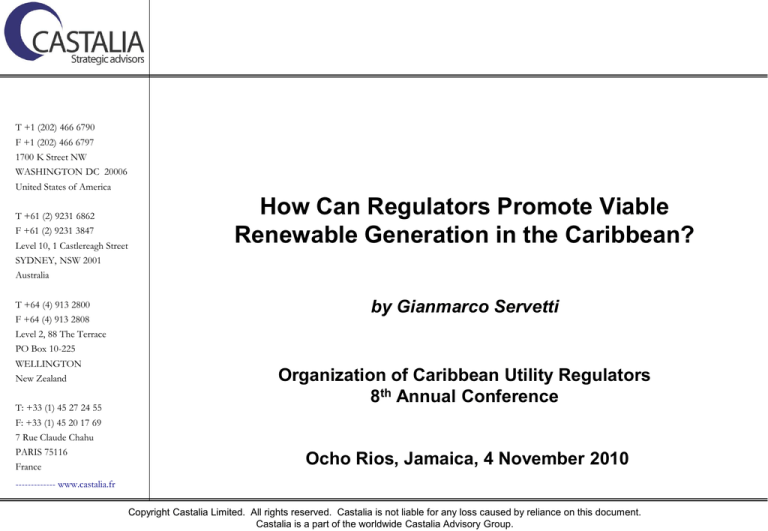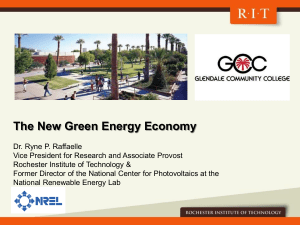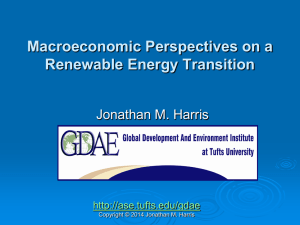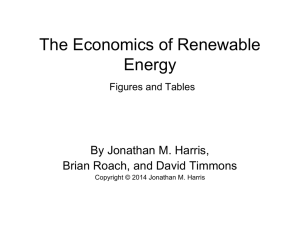
T +1 (202) 466 6790
F +1 (202) 466 6797
1700 K Street NW
WASHINGTON DC 20006
United States of America
T +61 (2) 9231 6862
F +61 (2) 9231 3847
Level 10, 1 Castlereagh Street
How Can Regulators Promote Viable
Renewable Generation in the Caribbean?
SYDNEY, NSW 2001
Australia
T +64 (4) 913 2800
F +64 (4) 913 2808
by Gianmarco Servetti
Level 2, 88 The Terrace
PO Box 10-225
WELLINGTON
New Zealand
T: +33 (1) 45 27 24 55
Organization of Caribbean Utility Regulators
8th Annual Conference
F: +33 (1) 45 20 17 69
7 Rue Claude Chahu
PARIS 75116
France
Ocho Rios, Jamaica, 4 November 2010
------------- www.castalia.fr
Copyright Castalia Limited. All rights reserved. Castalia is not liable for any loss caused by reliance on this document.
Castalia is a part of the worldwide Castalia Advisory Group.
Agenda
Barbados: unrealized renewable energy potential and carbon abatement
curve
Dominica: setting best practices rules while awaiting policy
Jamaica: competitive bidding for utility scale renewables
Cayman Islands: similar to Jamaica, but not yet implemented
Using regulation for promoting viable renewables—utility scale and
distributed scale
1
= Solar
LSD/Natural Gas estimated fuel cost
(US$0.06/kWh) and all-in cost (US$0.11/kWh)
Commercially viable
Economically viable
Wind (On-Shore), 10000 kW
0.11
Biomass Cogeneration, 20000 kW
0.11
LSD/HFO fuel cost: US$0.14/kWh
(utility), US$0.15/kWh (distributed)**
0.13
Wind (Off-Shore), 30000 kW
Gas Turbines fuel
cost: US$0.21/kWh**
0.13
Hybrid PV/Thermal, 2 kW
0.18
Municipal Solid Waste to Energy, 13500 kW
Residential tariff:
US$0.30/kWh
0.18
Seawater Air Conditioning, 2000 kW
PV Thin Film Fixed, 50 kW
= Commercial Scale
0.10
= Other
*
Solar Water Heater, 70 kW
= Wind
LSD/HFO all-in cost:
US$0.19/kWh
0.09
Solar Water Heater, 2 kW
= Utility Scale
Good renewable energy potential in Barbados—currently unrealized
0.25
LCPV Single Axis Tracking, 5 kW
LSD = low speed diesel
Non-residential tariff:
US$0.33/kWh
0.26
Wind, 10 kW
0.28
PV Thin Film Fixed, 2 kW
0.29
PV High-Efficiency Fixed, 50 kW
PV High-Efficiency Fixed, 3 kW
0.36
HCPV Dual Axis Tracking, 5 kW
0.36
= Solar
0.23
HCPV Dual Axis Tracking, 50 kW
= Small Scale
0.22
0.41
Wind, 1 kW
-
0.05
0.10
0.15
0.20
0.25
0.30
0.35
0.40
0.45
* For “Solar water heater, 70kW” the comparator is fuel oil boiler. ** ‘Fuel costs’ include variable O&M costs, and are grossed up for losses (6.6%) for distributed
technologies. Generation costs/tariffs based on oil prices US$100/bbl, and natural gas prices US$7/MMBTU. Natural gas generation contingent on planned Eastern
Caribbean Gas Pipeline
2
= Wind
US$/kWh
200
100
(200)
• Save money
• Reduce CO2e
3
• Good for the planet
• But cost money
• Who should pay?
•Globally good
projects
500
Wind, 1kW
Solar PV (HCPV, Dual Axis), 5kW
Solar PV (High Efficiency, Fixed), 3kW
Wind, 10kW
Solar PV (High Efficiency, Fixed), 50kW
Solar PV (Thin Film, Fixed), 2kW
Solar PV (LCPV, Single Axis), 5kW
Solar PV (HCPV, Dual Axis), 50kW
•Win-win projects
Solar Water Heater, 70kW
400
Solar PV (Thin Film, Fixed), 50kW
SWAC, 2MW
Waste to Energy, 13.5MW
Offshore Wind, 10MW
Onshore Wind, 10MW
300
Hybrid PV/Thermal, 2kW
Biomass Cogeneration 20MW
-
Solar Water Heater, 2kW
Barbados carbon abatement curve—how to promote good technologies?
US$26 per tCO2e
•Non-viable projects
(100)
•SWAC = Seawater Air Conditioning; HCPV = High Concentration PV; LCPV = Low Concentration PV
Dominica’s experience—setting best practice rules while awaiting policy
Developing a least cost expansion plan to add utility scale renewable capacity to the system:
DOMLEC to prepare an Integrated Resource Plan (IRP) and a Least Cost Expansion Plan (LCEP)
IRC to use the results of the plans ‘as the basis for determining the quantum of and timing for the
addition of new capacity’, and ‘promote the development of renewable energy resources for
inclusion in the generation mix (…) to the extent that renewable energy or alternative energy
are economically competitive with conventional generation technologies’*
Developing rules for supply of renewable energy to the grid by DOMLEC and third parties:
IRC envisages a process for adding new capacity whereby ‘all qualified organizations, including
DOMLEC, submit proposals to the IRC for satisfying demand’* based on the IRP and LCEP
IRC will ‘await the issue of the Government’s Policy on renewable energy before embarking
on any far reaching decisions for the introduction of these technologies into the public electricity
supply system’*— no policy statement yet that renewables should reduce electricity costs/prices
Establishing a licensing regime:
IRC can issue, monitor, amend, and revoke licenses (Electricity Supply Act, 2006)
Preparing an Interconnection Code for distributed renewable generation
IRC has stated that ‘DOMLEC is required to prepare and publish the procedure and terms for
interconnection of renewable and alternative energy generation sources owned by third parties to
the public electricity supply system’*
* IRC, Regulatory Policy and Procedure—Adding Capacity to the Public
Electricity Supply System, Decision, Document Ref: 2008/002/D
4
Jamaica’s experience—competitive bidding for utility scale renewables
Legal basis:
1. Licence of Jamaica Public Service
(JPS) mandates a tender process
for procurement of new capacity
>15MW
2. Office of Utility Regulation (OUR)
to manage the bidding process
Generation over 94% fossil-fuel based
Renewables about 5.5% of generation—8
small hydro, one 20MW wind farm
Situation
Over 26M barrels of oil imported annually
Policy Target
3. Agreement by which OUR does
Least Cost Expansion Planning
Distributed Scale:
Feed-In Tariff?
Utility Scale:
Tender/LCEP
Increase share of renewables generation to
11% by 2012, 12.5% by 2015, and 20% by
2030
Up to 640 GWh per year of renewable
electricity (about 70MW firm power)
By Independent Committee, in three steps:
1. Experience and financial assessment
1. JPS and OUR finalizing
a Standard Offer
Contract (SOC)
2. SOC to work under net
billing (avoided cost set
by OUR at US¢8.8 /kWh
for energy only), not net
metering
Evaluation
Negotiation
3. Tariff comparison—beat generation
avoided cost of conventional capacity and
energy (US¢/10.48kWh), +15% soft-cap
price premium (overall 12.05¢/kWh)
Highest-ranked bids invited to negotiate
Award
* All Island Electric Licence, 2001
2. Technical/environmental assessment
Single or multiple awards up to 640 GWh
per year
5
Cayman Islands’ experience—similar to Jamaica, but not yet implemented
Electricity Regulatory Authority (ERA) responsible for the solicitation process for new capacity*
based on least cost expansion plan prepared by Caribbean Utilities Company (CUC)
CUC files
Certificate of Need
(size and timing of
future
requirements of
firm capacity)
ERA approves
the Certificate
and prepares
solicitation
package
including
criteria and
timing for bid
Encouraging renewables:
ERA issues
RFP to
qualified
bidders
including CUC
(which drafts
PPA attached
to RFP)
ERA requests
EOIs with
minimum
threshold
requirements
ERA
assesses
bids (issues
generation
licence to
successful
bidders other
than CUC)
CUC
negotiates
eventual
PPA, to be
approved
by ERA
before it is
effective
ERA can choose a bid that is not lowest cost, if consistent
with evaluation criteria—if so, the CUC is compensated for
the difference… ultimately by customers
General solicitation process can include RE capacity, or there can be a RE-only solicitation
CUC can also consider renewables projects on a case-by-case basis and negotiate PPAs,
subject to approval by ERA and consistent with Government policy
Government policy is to determine how to encourage utility scale and distributed RE, ERA to
implement the policy
Cost of non-firm renewable capacity (including distributed) is to be subject to a direct passthrough to customers—CUC can propose this, and if it increases cost, recommend and justify a
limit on capacity; EAR to recommend to Government an appropriate policy framework
* Government of the Cayman Islands, Transmission and Distribution Licence
Granted to Caribbean Utilities Company, Ltd., 3 April 2008
6
Using regulation for promoting viable renewables—utility scale
Least cost planning that includes renewables
-
Require utility to do least cost planning and include reasonable renewable energy options,
assessed under various oil price scenarios
-
Regulator to check the least cost plan done by the utility rather than doing the least cost plan
itself, preserving the utility’s independence in managing its business
Options for adding new renewable generation that is economically viable
-
Auction: based on a least cost plan, it delivers ex ante approval of generation capacity through
a competitive process
-
Developed by utility without auction: traditional regulatory check is ex post (for example,
Barbados), but new technologies (especially for renewable generation) present uncertainties
and risks—when utilities ask for ex ante approval, regulators should go with that
-
Regime for third party utility scale generation:
Obligation for utility to purchase renewable power from third party suppliers when this is cheaper than
providing the power itself and does not compromise power quality and reliability
Utility calculates and publishes avoided costs
Regulator checks avoided costs calculations, publishes best principles for PPAs, approves PPAs
Third parties may challenge avoided costs and demonstrate they can generate reliable power at less
Grid Code—utility to prepare, regulator to check it does not impose undue
restrictions on third parties (also for distributed generation)
7
Using regulation for promoting viable renewables—distributed scale
Disaggregated, cost-reflective tariff structure (utility develops; regulator
approves):
-
Supply of energy
Connection to the distribution system
Provision of back-up and stand-by generating capacity
Feed-in tariffs and metering rules
-
Set feed-in tariffs at avoided cost (they are not necessarily a subsidy)
Cap distributed renewable capacity that can enjoy feed-in tariff
Set period for feed-in tariff based on system lifetime
Choose bi-directional metering/net billing over net metering
Spain’s experience with feed-in tariffs (‘solar gold rush’)
2007 Law: US¢44 per kWh for 25 years to solar PV (10 times 2007 average wholesale
price of US¢4), no cap
Target: 400MW of solar power by 2010, and promote domestic manufacturing industry
Result: 3,500MW by 2008, €126 billion in obligations to over 50,000 ‘solar entrepreneurs’
who often bought equipment abroad
Source: Bloomberg
Policymakers now considering pulling back… who will pay?
8
18 October 2010
Contact
Gianmarco Servetti
Manager, Castalia
1700 K Street NW Suite 410, Washington DC (United States)
202 4666790 (office), 202 550 3998 (cell phone)
gianmarco.servetti@castalia-advisors.com
9








